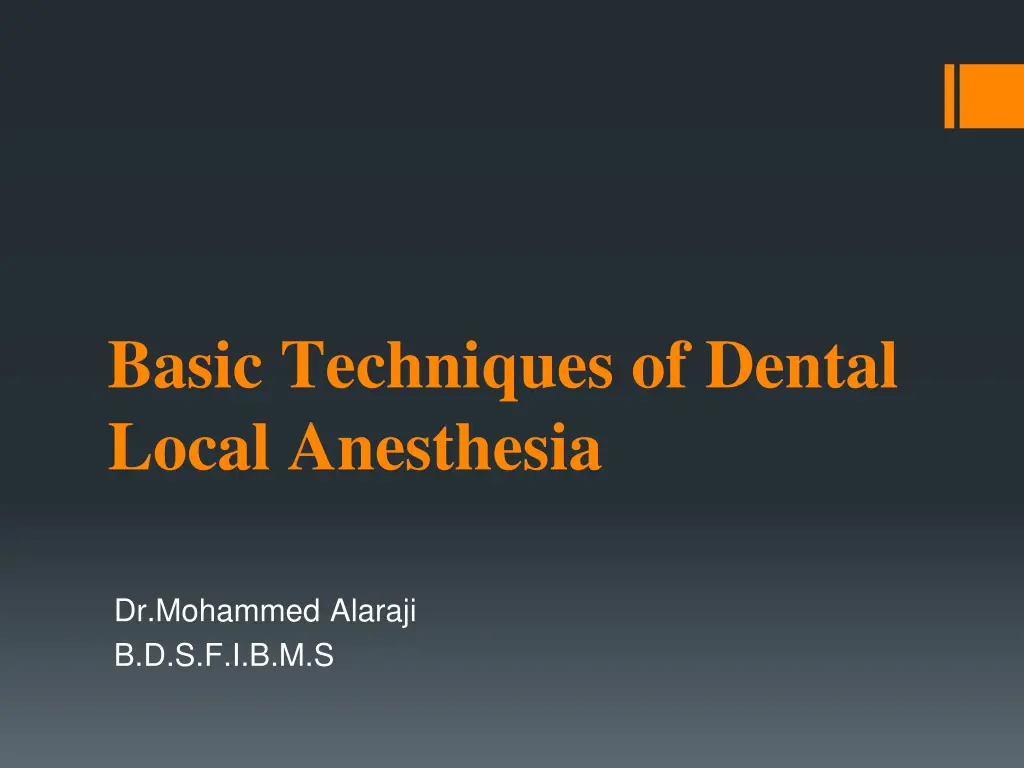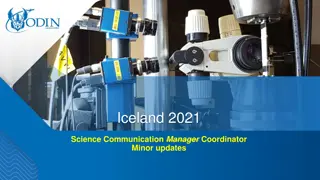
Advanced Techniques of Dental Local Anesthesia and Applications
Explore the advanced methods of dental local anesthesia by Dr. Mohammed Alaraji, covering topical anesthesia, infiltration anesthesia, and regional block anesthesia. Learn about the benefits, techniques, and types of infiltration anesthesia for effective pain management during dental procedures.
Download Presentation

Please find below an Image/Link to download the presentation.
The content on the website is provided AS IS for your information and personal use only. It may not be sold, licensed, or shared on other websites without obtaining consent from the author. If you encounter any issues during the download, it is possible that the publisher has removed the file from their server.
You are allowed to download the files provided on this website for personal or commercial use, subject to the condition that they are used lawfully. All files are the property of their respective owners.
The content on the website is provided AS IS for your information and personal use only. It may not be sold, licensed, or shared on other websites without obtaining consent from the author.
E N D
Presentation Transcript
Basic Techniques of Dental Local Anesthesia Dr.Mohammed Alaraji B.D.S.F.I.B.M.S
1. Topical anesthesia 2. Infiltration anesthesia 3. Regional block anesthesia
Topical or Surface Anesthesia Small terminal nerves in the surface area of the intact mucosa or the skin (superficial nerve ending) up to the depth of about 2 mm are anesthetized by application of topical anesthetic agent directly to the area. This method is commonly used to: 1. Obtain anesthesia of mucosa prior to injection, making the insertion of the needle less painful. 2. prior to carrying out incision and drainage of abscesses. 3. prior to suture removal.
Examples of topical anesthesia's preparation: Lidocaine Spray: Ointments: containing 5 % lidocaine hydrochloride, Ethyl chloride spray:
Infiltration Anesthesia In this method, the anesthetic solution deposited near the terminal fibers of any nerve. It will infiltrate through the tissue to reach the nerve fibers and thus produce anesthesia of the localized area served by them. The maxilla has thin labial / buccal cortical plate, shows sites of porosity, which aid in the absorption of the local anesthetic solution. These factors, therefore, make the maxilla more favorable for infiltration anesthesia. The mandibular bone is generally dense and has thicker cortical plates than the maxilla, particularly in the posterior region, so only the anterior part of the mandible presents sufficient porosity, which is favorable for the infiltration.
Advantages: 1. Easy and simple injection 2. Very high success rate Disadvantage: Its action is limited to a small area; hence, a considerable amount of solution has to be injected with multiple penetrations when a large field is to be anesthetized.
Technique: care should be taken to avoid injury to the tissue in the following ways: 1. Avoid injecting the solution too rapidly. 2. Avoid injecting too large volume of the local anesthetic solution. 3. Avoid injecting too superficially. These situations will result in injury to the tissue in the form of pain at the time of injection, or persistent post - injection pain.
Types of infiltration anesthesia 1. Sub-mucous injection: the solution deposited just beneath the mucous membrane; the solution diffuses through the interstitial tissue and reaches the terminal fibers of the nerve in the area of deposition. This technique is unlikely to produce anesthesia of the dental pulp it is often employed to anesthetize the long buccal nerve prior to the extraction of mandibular molars or for soft tissue surgery.
2. Supra-periosteal injection: in some sites, such as maxilla, the outer cortical plate of alveolar bone is thin and perforated by tiny vascular canals. In these areas when the anesthetic solution is deposited outside the periosteum. It will infiltrate through the periosteum, cortical plate, and medullary bone to the nerve fibers. By this means, anesthesia of the dental pulp can be obtained by injecting near the tooth apex. The supra-periosteal injection is the technique most frequently used in dentistry.
3. Sub-periosteal injection: the solution is deposited between the periosteum and the cortical plate. This technique is painful since the periosteum is firmly attached to the cortical plate.
"Regional block anesthesia" In this technique, the anesthetic solution deposited near the main nerve trunk, usually at a distance from the site of the surgical procedure and this will lead to blocking all impulses and produce anesthesia of the area supplied by that nerve. Example: by placing the anesthetic solution in the pterygomandibular space, near the mandibular foramen, regional block anesthesia over the whole distribution of the inferior alveolar nerve on that side is obtained.
Local anesthesia in the maxilla
Anesthesia for the upper molar teeth The pulps of the upper molars with the exception of the mesiobuccal root of the first molar are innervated by the posterior superior alveolar nerve. This nerve is also responsible for innervations of the alveolar bone, buccal gingiva in the molar region and the mucoperiosteum attached to them.
Posterior superior alveolar nerve block The local anesthetic solution is deposited close to the posterior superior alveolar nerve after it leaves its bony canal. Technique: 1. Partially open the patient's mouth 2. Retract the patient's cheek with your finger 3. Insert the needle into the height of the mucobuccal fold opposite to the distal surface of the maxillary second molar 4. Advance the needle in upward, inward, and backward direction. One of the disadvantages of this technique is the possibility of damaging the pterygoid venous plexus and the risk of hematoma formation.
Anesthesia of the upper premolar teeth: The mesiobuccal root of the upper first molar, both premolars, and buccal supporting tissue and mucoperiosteum related to them are innervated via the middle superior alveolar nerve. Infiltration technique is usually employed to anesthetize these structures.
Anesthesia of the upper anterior teeth: The upper canine, central and lateral incisors, labial supporting tissue and mucoperiosteum related to them are innervated via anterior superior alveolar never. Infiltration technique is usually employed to anesthetize these structures.
Anesthesia of the palatal tissue Anesthesia of the posterior portion of the palate could be achieved by infiltration technique (the solution is deposited in the palatal tissue about halfway between the midline and the gingival margin of the target tooth at an angle of 45 to the bony surface), or by using greater palatine nerve block (the solution is deposited near the greater palatine foramen, located just distal to the maxillary second molar about 1 cm toward the midline).
Anesthesia of the anterior portion of the palate could be achieved by infiltration technique, just next to the target tooth, or by nasopalatine nerve block, where the solution is deposited near the incisive foramen (located in the midline of the palate about 1 cm posterior to the maxillary central incisors).
The infra-orbital nerve block injection: This technique is rarely used since the infiltration techniques are so effective in the maxilla, however, it may be of value if numerous extractions or extensive surgery are to be undertaken in the maxillary incisor and canine regions. It may also be employed for anesthetizing an anterior tooth where the use of infiltration technique is precluded by the presence of infection at the site of injection.
Maxillary nerve block The maxillary nerve and all its branches will be anesthetized. These blocks are used for achieving anesthesia of half of the maxilla in extensive surgery. This technique could be used for diagnostic or therapeutic purposes such as trigeminal neuralgia of the maxillary division of the fifth cranial nerve.
Anesthesia of the lower anterior teeth The lower anterior teeth are supplied by the terminal branch of the inferior alveolar nerve (incisive nerve). Fortunately, the labial alveolar plate in this region is thinner and more porous than elsewhere in the mandible and because of that, the infiltration technique could be used in this area. The mental nerve blocks This block will anesthetize the pulp and periodontal membrane of the lower incisors, canine. labial mucous membrane anterior to the mental foramen and the skin of the chin and the skin and mucosa of the lower lip (mental nerve).
Anesthesia of the lower premolars and molars To extract the lower premolar and molars we should anesthetize the inferior alveolar nerve (supply the pulp of these teeth with their periodontium and the bony socket), the lingual nerve (supply the lingual soft tissue adjacent to them) and the long buccal nerve (supply the buccal soft tissue). In children, multiple vascular canals perforate the thin labial/buccal alveolar plate. For this reason, infiltration techniques are highly effective in producing anesthesia of upper and lower deciduous teeth.
Inferior alveolar nerve block The IAN, along with its terminal branches (incisive and mental nerves) are anesthetized by this technique (anesthesia of the pulp of all mandibular teeth in the same side of injection, the skin of the chin and the skin and mucosa of the lower lip). This is achieved by the deposition of the solution around the mandibular foramen in the pterygomandibular space. The inferior alveolar nerve block technique
Long buccal nerve block The long buccal nerve provides sensory innervations to the buccal soft tissue adjacent to the mandibular molar teeth, vestibular mucosa, and mucosa of the retromolar fossa. A long buccal nerve block is achieved by means of a sub-mucous injection in which the solution is deposited (few drops) just posterior and buccal to the last molar tooth in the arch (between the external and the internal oblique ridge). Infiltration technique for the long buccal nerve is achieved by deposition of the solution in the Muco-buccal fold adjacent to the target tooth.
Supplementary Injections 1. Intra-ligamentary (periodontal) injection: the local anesthetic solution is deposited into the periodontal ligament, using a small amount of local anesthetic solution usually 0.2 ml delivered via a specifically designed system which comprises of high- pressure syringes and ultrafine needles. This technique can also be carried out by the conventional syringes.
2. Intrapulpal anesthesia: put a cotton ball soaked in a local anesthetic solution in the cavity, wait for a minute and then a needle is inserted firmly directly into the pulp chamber or to the root canal.
3. Intraosseous injection: In this rarely used method, the local anesthetic solution is deposited directly into the cancellous bone adjacent to the tooth to be anesthetized. An incision is made in the mucosa and the periosteum, a small opening is made in the outer cortical layer of the bone. The needle is inserted into the opening created, and approximately 0.5-1 ml of solution is slowly injected under pressure. Anesthesia by the intraosseous method will not be of very long duration, possibly between 10-20 minutes.
Testing for anesthesia Altered sensation in itself does not guarantee that anesthesia has been achieved, prior to extraction under local anesthesia a dental probe may be pushed into the gingival crevice on both the labio- buccal and the lingual surface of the tooth. The patient should be told that pressure might be felt and asked to state if sharpness is noted, the presence of sharpness is an indication of a further injection.






















